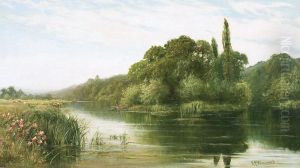J.G. Kinnaird Paintings
J.G. Kinnaird, born in 1820 and passing away in 1866, was a British artist known for his picturesque landscapes and detailed architectural watercolors. His full name, John George Kinnaird, may not be widely recognized in the mainstream art history narratives, but his contributions to Victorian art and his depiction of rural and urban British scenes have garnered him a respected place among collectors and historians of British watercolor painting.
Kinnaird was part of the British watercolor movement, a period that saw a significant evolution in the use of watercolors from mere sketches or preparatory studies to finished works of art. This movement coincided with a broader interest in landscape painting in Britain, influenced by Romanticism and the works of artists like J.M.W. Turner and John Constable. Kinnaird’s work, however, leaned more towards the detailed and sometimes idyllic representations of England's countryside and its historic buildings, reflecting a Victorian fascination with the pastoral and the picturesque.
Despite the lack of extensive documentation on Kinnaird’s life, it is known that he worked during a time of great social and technological change in Britain. The Victorian era was marked by the Industrial Revolution, urbanization, and significant developments in the arts and sciences. Kinnaird’s paintings, with their focus on more timeless rural landscapes and heritage sites, served as a form of escapism and nostalgia for an England that was rapidly modernizing.
Kinnaird exhibited his works at various prestigious institutions, including the Royal Academy and the British Institution, which were key platforms for artists of his time. His ability to capture the nuanced play of light and shadow, using the watercolor medium with skill and sensitivity, was noted in his lifetime and continues to be appreciated.
After his death in 1866, J.G. Kinnaird's works continued to be collected and admired, though like many artists of his era, he did not achieve the enduring fame of some of his contemporaries. Today, his paintings can be found in private collections and occasionally appear in auctions, where they are sought after by enthusiasts of Victorian art and the British watercolor tradition. Kinnaird's legacy, while modest in comparison to the giants of British art, is a testament to the depth and diversity of talent in the 19th-century British art scene.


